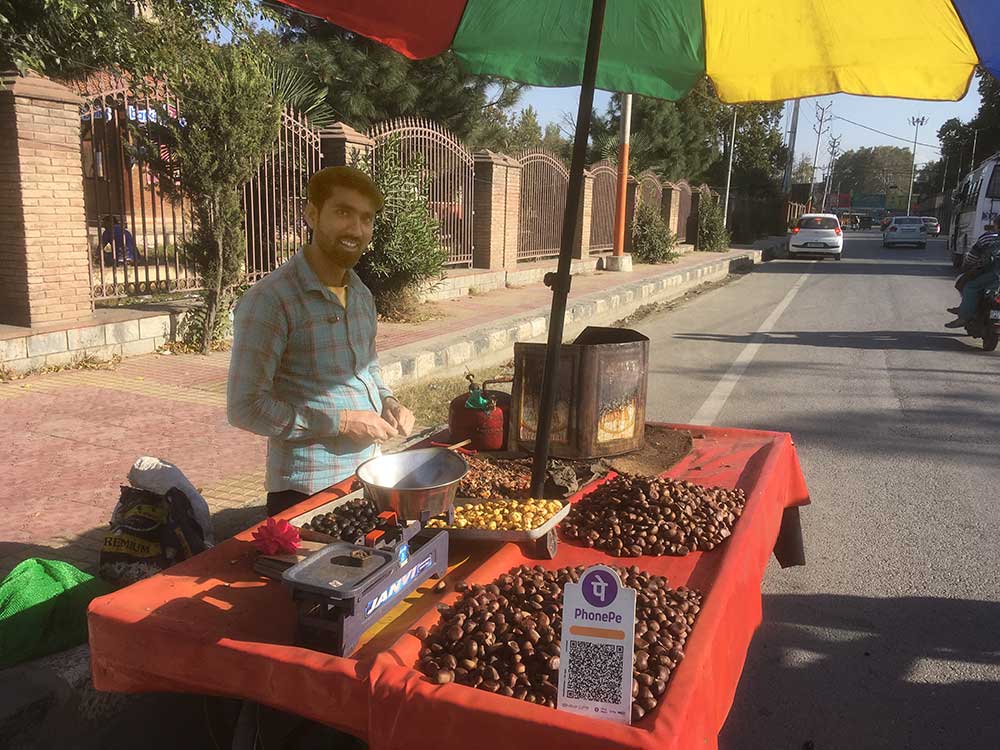by Peer Mohammad Amir Qureshi
Regrettably, a few years ago, the guardian of the cherished shop pruned the branches of the two chestnut trees. The intrusion of children throwing pebbles had irked the new custodians. Today, the once abundant and delectable chestnuts have diminished both in quality and quantity, symbolising the changing times and the altered custodianship of the precious orchard.

In the comfort of my home, wrapped in a warm blanket, I immersed myself in the pages of a book. The tranquillity of solitude was disrupted by the melodious ring of my phone. Retrieving it from my pocket, I noticed a call from my friend, Adil Rehman, inviting me to join him. Responding to his prompt, I headed towards an orchard, a familiar meeting place.
As I approached, a charming scene unfolded — a group of lively children gathered around a majestic chestnut tree. The deciduous trees, known as Punjab Gaer, bore treasure-laden branches, and the children enthusiastically threw pebbles to dislodge the chestnuts encased in prickly husks. Observing this nostalgic tableau, memories of my youthful adventures flooded back.
I reminisced about the two chestnut trees that once adorned my village, a rarity in the district of Ganderbal. Local lore held that these venerable trees were planted by Haji Ghulam Rasool of Habba Kadal, Srinagar, a legacy that endured for at least seven decades. According to the wisdom passed down by the village elders, there was a time when a playground graced the landscape, serving as a gathering place for children. It was during this period that the roots of the two chestnut trees were planted.
However, the passage of time brought change, transforming the terrain into an orchard adorned with apples and various plum trees. Eventually, the orchard changed ownership, finding a new caretaker in Nowshera, Srinagar. The guardianship of the garden transitioned to the capable hands of the Gujjars, who not only tended to their cattle but also nurtured the flourishing orchard.

Two chestnut trees, standing as quiet sentinels along the roadside, are a distinctive presence. Notably, the stewards of the neighbouring orchard have never raised objections to the seasonal practice of collecting the prized chestnuts, locally referred to as Punjab Gaer. In my reflection, these chestnut trees seem to be a benevolent gift to the entire village. As autumn painted the surroundings with vibrant hues and winter’s chill set in, the abundant fruits adorned the branches, attracting children.
This communal treasure remains freely accessible within the public domain, absent any restrictions imposed by the vigilant guardians of the orchard.
The memory remains vivid: with Gowhar at my side, we frequented the orchard, attentively monitoring the ripening chestnuts. Our patience, however, faced a setback one year when other children from our village harvested the branches, leaving us disappointed. Typically, the orchard bore fruits during the departure of the Bakarwals to Jammu, vacating their kitchens by the orchard where they cooked on traditional Daanbur.

Undeterred, we proceeded to open the chestnuts nestled in spiky husks, gathering straws to ignite the Daanbur. The crackling sound of chestnuts bursting into a flavourful blaze became a joyous symphony. Passersby on the road couldn’t resist joining our endeavour, captivated by the enchanting taste of chestnuts. Particularly, the younger ones were fervent followers, drawn into the allure of these mesmerizing chestnuts.

Regrettably, a few years ago, the guardian of the cherished shop pruned the branches of the two chestnut trees. The intrusion of children throwing pebbles had irked the new custodians. Today, the once abundant and delectable chestnuts have diminished both in quality and quantity, symbolising the changing times and the altered custodianship of the precious orchard.
The shifting sands of time and the evolving nature of people serve as a stark reminder. There’s a looming apprehension that the hands of progress might fall those venerable trees in the future. Yet, the indelible memories woven with those trees persist, eternally fresh in our minds, akin to a conversation held just yesterday.
May the children of future generations savour the essence of those chestnuts, cultivating a connection with the past that transcends the passage of time.
(The author, a columnist based in Ganderbal, holds a Master’s Degree in Zoology. He X’s as @peermohdamir. Ideas are personal.)















